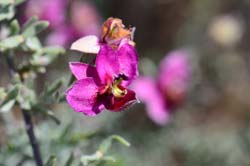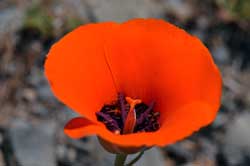Southwest Desert Flora
Welcome to Southwest Desert Flora, an on-line guide for those curious about wildflowers and natural vegetation in the southwest, primarily Arizona. This site includes photographs and detailed descriptions of beautiful and sometimes rare plants that have adapted to and thrive under harsh conditions typical of North America deserts and transition areas. The southwestern United States contains some of the most extreme and diverse habitats known and Arizona is located geographically in the center of this unique assemblage of habitats. It is home to some of the most diverse flora and fauna representatives in the world. Many of these plants are difficult to observe and photograph because many may not bloom every year while others occur in sporadic distributions and have a short window of opportunity in which to witness them in bloom.

As is the case with most educational sites where information is constantly gathered or changing this site is always under construction. You will note that we have many more families to add and we are currently working to that end. We have on hand, photographs representing more than 50 additional families and additional photos are added regularly. Some of the families posted here are already in need of updates as new species have been added to the photo library. So please bear with us and we hope you enjoy our site! Please do not hesitate to contact us at the address above if you have any questions and we always appreciate your comments. Thanks.
The plants included in this site are either native, endemic or invasive to one or more of the four major deserts in southwest North America which include the Sonoran, Chihuahuan, Mojave and the Great Basin. Also included are profiles for plants found in desert transition areas or higher elevation species found in neighboring upland and mountain areas. Transition and other habitat types are often encountered when hiking trails or spending time exploring southwest wild areas. Such non-desert plants included here are identified in text. Each desert is further defined by its own set of unique physical and biological properties such as rainfall, temperature and unique associations or assemblages of plants.
Whether for a casual or serious student of wildflowers or an outdoor enthusiast and those curious about plants observed in nature, Southwest Desert Flora provides a balance between photographs and technical descriptions of plant characteristics.
Welcome and begin your exploration.

The Southwest Deserts: The North American deserts identified above are geographically limited to: southeast California; southern Nevada and Utah; central, southern and western Arizona; southwest New Mexico; west Texas and northern Mexico. Located almost in the center is the state of Arizona whose extreme climate and physical conditions provide some of the most diverse biotic communities found anywhere in the world. In fact, examples of almost all of the world’s biotic communities are each represented in Arizona. In Arizona elevations range from over 12,000 feet on the San Francisco Peaks near Flagstaff, to near sea-level along the Colorado River south of Yuma. These communities, or biomes, found in Arizona include the Tundra, Coniferous Forests, Temperate Deciduous Forests, Grasslands, Chaparral, Deserts and Thornscrub, a semi-tropical habitat found in the southern part of the state. Deserts are well represented in Arizona which is the only state where all four North American deserts are joined in transition! Each desert is special and characterized in part by its own unique vegetation, climate and physical characteristics.


